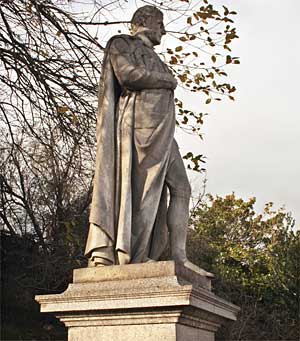
E B Stephens - sculptor
Return to Exeter People Menu
Arguably, Exeter's finest sculptor, Edward Bowring Stephens was born in 1815; his father, James Stephens, was a figurative stone mason, whose skills were passed on to his son. The young Stephens' initial artistic training was under John Gendall, who ran drawing classes from his premises at Mols Coffee House. In 1835, Stephens became a pupil of Edward Hodges Baily the sculptor, whose work for Buckingham Palace may have helped his pupil a few years later. The next year, Stephens won a silver medal for a maquette of a figure from the Society of Arts and he became a student at the Royal Academy of Arts.
Stephens first exhibited his work in 1838, and in 1839 he travelled to Italy where he remained for three years, working and studying. He returned to Exeter, where he was commissioned to produce a life size marble statue of Lord Rolle before moving back to London. In 1843 he was awarded a gold medal by the Royal Academy for a relief of the Battle of the Centaurs and Lapithae.
After E B Stephens married Jane Harris Emes at Crediton in 1845 he was engaged to produce a two group Satan Vanquished and Satan Tempting Eve for a chimney-piece at Buckingham Palace. This was a fortunate commission for it was exhibited at the Great Exhibition in 1851, gaining him more recognition.
Over the next ten or so years he was busy on commissions for busts of Lord Palmerston, the irascible Bishop Phillpotts of Exeter, the Earl of Devon Lord Courtenay, Earl Fortescue, as well as works for exhibition in the Royal Academy such as Eve Contemplating Death (1853) and the Angel (1861). He was elected an Associate of the Royal Academy, in 1864.
Exeter, Stephens' native city, had not forgotten him and, in 1862, he produced a large marble statue to be placed in Northernhay Park, of Sir Thomas Dyke Acland (1861), who had been a Devon MP for many years. Other local commissions followed, with a statue of the Earl of Fortescue (1863), which can be seen in Castle Yard, a statue of John Dinham (1866), a marble statue of Prince Albert (1868) for a nominal sum, which can be seen at the Royal Albert Memorial Museum and what is considered to be his finest work, the bronze Deerstalker (1876) that is also in Northernhay Park. The unveiling of Stephens' latest work in Northernhay was always accompanied by large crowds, sometimes in the thousands, and a band to play the National Anthem; how much of this was for Stephens, rather than the subject of the sculpture, is a matter of conjecture.
He spent some time back in Exeter, for he is mentioned in a case regarding his failure to declare the employment of a man-servant to the Inland Revenue in 1871, when he was living at Fore Street.
Stephens encouraged the formation of the School of Art, and the later plans for it to be incorporated into a city museum. In 1862 he offered "casts of every work of his which might be thought worthy of acceptance" for the planned museum. When John Gendall died in 1865, Stephens tried to organise an appeal for funds to purchase his former teacher's many prints and paintings from Gendall's wife, for the museum, but without success.
E B Stephens died at the age of 67, on 10 November 1882 at his home in London. The next year, the Earl of Devon offered to organise the purchase of 'The Bathers' for the museum, but it did not happen. However, the city does have five fine examples of his work, one of which, 'The Deestalkers', is considered the finest piece he produced.
Source: Trewmans Exeter Flying Post and the Oxford National Biography.
 The statue of Prince Albert in the RAMM.
The statue of Prince Albert in the RAMM.
 The statue of the Earl of Fortescue in Castle Yard.
The statue of the Earl of Fortescue in Castle Yard.
│ Top of Page │